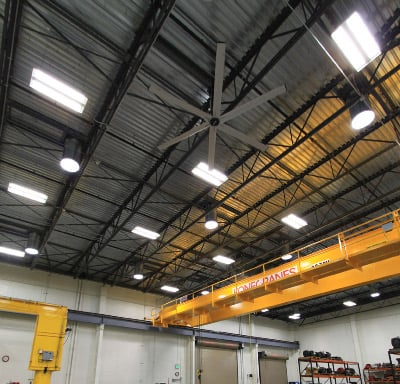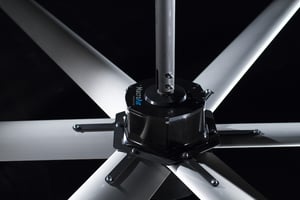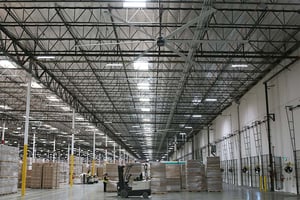The rules of nature tell us that warm air rises up towards the ceiling. We know this, but have you...
The Most Common Questions about HVLS Fans
First-time buyers tend to have a lot of questions about HVLS fans. After decades in the industry, MacroAir has heard many of them. To help facility managers, architects, and engineers who are in the process of buying or researching HVLS fans, we've assembled a list of the most common questions about HVLS fans we hear from our customers. And to help you with further research, we've provided links to related blog posts under each question.
1. How do I know that I need an HVLS fan?

If you have a large facility that needs airflow throughout the entire space, an HVLS fan is a great solution for you. The fan can also help you in the following situations:
- High humidity causes a buildup of moisture in my facility
- I don’t have an HVAC system and need to keep my occupants comfortable
- My HVAC system does not evenly distribute heat/cool
- I need to reduce energy consumption
6 Easy Tips to Improve Warehouse Air Circulation
2. Does an HVLS fan use a lot of electricity?
No. Even if you leave it on around the clock, a well-designed HVLS fan, like the latest technology AVD3, can run for only $0.43 a day.
Step-by-Step Guide to Reduce Energy Costs with HVLS Fans
Integrate MacroAir HVLS Fans in Building Plans for Energy Savings
3. Do I need an HVLS fan if I already have a good HVAC system?
Possibly. HVLS fans evenly distribute air which improves the effectiveness of your HVAC system. Minimizing your HVAC system’s run time saves energy and prolongs the unit’s lifespan.
Effectiveness of HVLS Fans with and Without HVAC Systems
HVLS Fans and HVAC: A Perfect Partnership
4. I need to cool an extremely large space. Will an HVLS fan help?
Yes. HVLS fans can be as large as 24 feet in diameter and can cover an area of over 20,000 square feet. They are frequently used to cool facilities with more than 100,000 square feet and are an ideal solution for warehouses that have open bays and frequent air exchange.
5 Problems With HVAC Systems in Large Facilities That You Might Not Have Considered
How to Cool Off a Warehouse - Top 10 Ways
5. How do I know which size HVLS fan I need?
The primary indicators are the size of your space and the amount of airflow you need. Other factors include building compatibility, usage, and budget.
How to Choose the Best HVLS Fan for Your Facility
What are the Typical Mounting Options for HVLS Fans
6. How long is the warranty on an HVLS fan?
The warranty on an HVLS fan varies by manufacturer and ranges from a few years to decades. Some manufacturers reduce the warranty in half if another service provider installs their fan. Other manufacturers offer a full warranty regardless of who installs it. MacroAir offers a 50,000 hour warranty on its AirVolution-D, regardless of who installs it.
7. Should an HVLS fan have winglets like an airplane?
The small, curved caps added to the edge of some HVLS fan blades have sparked much debate. Some companies add winglets to capture and move more air. However, winglets negatively impact the performance of an HVLS fan by increasing the amount of energy the fan uses and making the fan wear out faster.
Winglets: Help or Hindrance for HVLS Fans?
8. Is it expensive to repair an HVLS fan if something goes wrong?
It varies. If your fan is warrantied by a manufacturer with an excellent warranty and service, it’s not. However, it can be expensive if your fan is out of warranty or if it has sustained serious damage. Because of the moving parts, the motor in a traditional HVLS fan sustains the majority of wear and tear. Choosing a modern HVLS fan with a gearless motor eliminates that wear and tear and elongates the product’s lifetime.
How to Choose an HVLS Fan with the Lowest Maintenance and Repair Costs
9. How do I know where to place an HVLS fan?
A trained HVLS fan specialist should help you decide where to place an HVLS fan based on the size of the fan and the layout of your space. Some HVLS fans without modern technology will have variable frequency drives (VFD). Correct placement on those is crucial or your HVLS fan won’t run optimally. Consider a direct drive HVLS fan for more installation flexibility.
3 HVLS Fan Placement Tricks that Reduce Costs
What’s the Most Common HVLS Fan Installation Issue
10. What's the difference between a fan with 3 blades, 6 blades, and 10 blades?
The differences are the amount of airflow the fan can produce, the energy it uses, and how it affects your building's infrastructure. Different manufacturers have varying beliefs on how many blades are best for specific situations.
6 vs. 10-blade HVLS Fans: Cost and Comparison
11. How loud is an HVLS fan?
HVLS fans are much quieter than HVAC systems and pedestal fans. New HVLS fans with direct drive motors (unlike traditional motors with gears) are even quieter than older HVLS fans still on the market today.
Make Your Workspace Cool and Comfortable Without the Extra Noise
12. My facility gets extremely hot. Can an HVLS fan run safely in it?
Yes. The AirVolution-D is rated for temperatures up to 140°F. Having a high heat rating is very important because when an HVLS fan is not running, the temperature at the ceiling is much higher than at ground level.
HVLS Fans Decrease Employee Heat Stress
13. Can I use an HVLS fan to improve the air quality of my facility?
Yes. Because HVLS fans promote airflow throughout large areas they can be used to eliminate fumes and prevent air quality problems like Sick Building Syndrome (SBS).
Avoid Sick Building Syndrome with HVLS Fans
How to Improve Air Quality for Warehouse Workers
14. What should an HVLS fan's blades be made out of?
HVLS fan blades should be extremely durable and resistant to extreme temperatures and moisture. MacroAir uses aluminum that has been anodized (an electrochemical process that makes aluminum extremely strong).
Why Anodized Aluminum Fan Blades Are Superior
The Bottom Line

There are many elements involved in choosing the best HVLS fan solution for your facility. We know that purchasing an HVLS fan is a large decision and understanding the new technology comes with a lot of questions. We hope that answering some of the most common questions about HVLS fans we receive helps you.
Have additional questions about HVLS fan technology? Contact one of our knowledgeable customer care representatives today. They are eager to answer all your HVLS questions.


